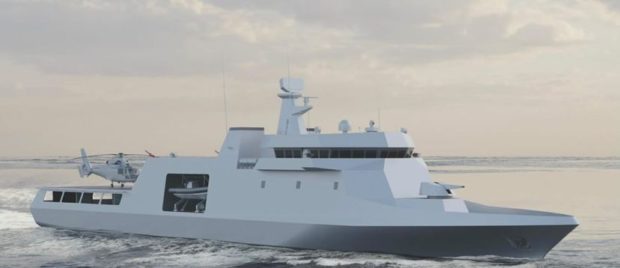Navy to order 6 more patrol vessels from South Korea

The Philippines picks South Korean shipbuilder Hyundai Heavy Industries to build six offshore patrol vessels for the Philippine Navy for P30 billion. The HHI’s OPV offer is based on HDP-1500 Neo design. (HHI)
MANILA, Philippines — The Philippines will order six offshore patrol vessels (OPVs) for P30 billion from South Korean shipbuilder Hyundai Heavy Industries (HHI) to boost its capability to protect national interests, particularly in the West Philippine Sea.
“I’m waiting for the Navy to finalize the terms of reference….We are close to issuing (the notice of award). I hope I can sign the contract before I leave office [on June 30]. The Navy has chosen Hyundai Heavy Industries to build the OPVs,” Defense Secretary Delfin Lorenzana told reporters on the sidelines of the Philippine Navy anniversary on Friday.
Boost inadequate fleet
Hyundai’s OPV offer is based on the HDP-1500 Neo design, which was presented at the Asia Defense and Security 2022 exhibition held in Manila last month. With an overall length of 81 meters, a displacement of 1,700 tons and a maximum speed of 21 knots, the new patrol ships are expected to be armed with 76mm naval guns and autocannons in remote controlled weapon stations.
They will also have provisions for antiship missile launchers, torpedo launchers, and a short range air defense system. They are seen as a boost to the Navy’s inadequate fleet, which saw the decommissioning of World War II-era vessels starting in 2020 without immediate replacements. The ships will be delivered yearly in batches of two, with the first batch expected to arrive four years after the contract signing.
Lorenzana said he hoped the incoming administration would continue the military’s modernization program.
The South Korean government is expected to hand over an additional refurbished Pohang-class corvette with the purchase of the OPVs, said a security official with knowledge of the deal’s details but not authorized to speak to the media. The Navy is also awaiting the transfer of a decommissioned Pohang-class corvette after the Philippines ordered two corvettes from HHI in December.
Hyundai—one of the world’s largest shipbuilders—beat Turkey’s ASFAT, its biggest rival for the Navy’s OPV acquisition project. Australian shipbuilder Austal was initially the preferred supplier since 2018, but the Department of Defense scrapped its plans in March after the former raised the price from P30 billion to P42 billion due to rising production costs.
The security official told the Inquirer that from May 10 to 14, the Navy conducted a postqualification inspection for the OPVs in South Korea and a recommendation to the special bids and awards committee was made on Friday.
Third contract
The impending contract with HHI will be the third for the Philippine government, following a deal in December for two corvettes worth P25 billion. The first deal, signed six years ago for two missile-capable frigates now known as Jose Rizal-class frigates worth P16 billion, was marred with controversies over the selection of combat management systems, prompting South Korea’s Ministry of Defense to settle the dispute.
The Korean government is also expected to turn over a refurbished K136 Kooryong multiple launch rocket system to the military next month.
A 10-man contingent from the Philippine Army and Philippine Marine Corps—the end users of the system—left for South Korea early this month to undergo training on its maintenance, operation and live firing, a defense official told the Inquirer.
Seoul is donating 22 K1361A rocket launchers, 22 KM809A1 rocket launcher trucks, 22 M60 ammunition carrier trucks and over 50,000 rocket ammunition to the military as excess defense articles.
Newest addition
The Philippine Coast Guard (PCG), on the other hand, will be getting an addition to its maritime assets with the arrival of its second 97-meter multirole response vessel (MRRV) next month.
The newest arrival will be named BRP Melchora Aquino. The first one, the BRP Teresa Magbanua, was recently commissioned into service.
According to the PCG, the second vessel is now at Shimonoseki Shipyard in Yamaguchi Prefecture in Japan, undergoing the last “harbor acceptance test and inspection.”
An inspection team will assess its functionality, quality and acceptability of works, equipment, machinery, parts and systems to ensure that technical specifications in the contract have been fully complied with.
The vessel will leave Japan on May 27 and is expected to arrive in the country on June 1.
Like BRP Teresa Magbanua, BRP Melchora Aquino was modeled after the Kunigami-class vessel of the Japanese Coast Guard, with a speed of 24 knots.
Able to withstand harsh weather conditions, it has also a maximum endurance of 7,408 kilometers (4,000 nautical miles), which makes it capable of conducting sustained maritime patrols in the country’s maritime jurisdiction.
The MRRVs will be used to strengthen the PCG’s maritime security, safety, law enforcement, search and rescue, and marine environmental protection capabilities.
In an earlier interview, PCG spokesperson Commodore Armand Balilo said that part of the new ships’ deployment would be the West Philippine Sea.
They can be deployed for longer period of time, around 15 to 20 days, compared to three to five days for the PCG’s other ships.
The new vessels were acquired by the Department of Transportation for the PCG under the Maritime Safety Capability Improvement Project Phase II project, funded by an Official Development Assistance loan from the Japan International Cooperation Agency. —WITH A REPORT FROM TINA G. SANTOS
READ: PH Navy acquires supersonic missiles from India
Disclaimer: The comments uploaded on this site do not necessarily represent or reflect the views of management and owner of Cebudailynews. We reserve the right to exclude comments that we deem to be inconsistent with our editorial standards.
